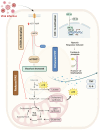Metabolic reprogramming in viral infections: the interplay of glucose metabolism and immune responses
- PMID: 40453076
- PMCID: PMC12122472
- DOI: 10.3389/fimmu.2025.1578202
Metabolic reprogramming in viral infections: the interplay of glucose metabolism and immune responses
Abstract
Metabolic reprogramming is an important player within the immune response to viral infections, allowing immune cells to fine-tune their energy production and biosynthetic requirements while it is actively working to restrict pathogen access to essential nutrients. Particularly, glucose metabolism, which appears to be one of the important regulators of immune function, affects immune cell activation, cytokine secretion, and pathogen restriction. This review explores the mechanisms of metabolic reprogramming during viral infections, with a specific emphasis on glucose metabolism. We discussed the key cytokines involved in orchestrating this metabolic process and the influence of pre-existing metabolic disorders on immune efficiency. Furthermore, we introduced emerging therapeutic strategies that target glucose metabolism to enhance antiviral immunity and improve disease outcomes. A deeper understanding of the interaction between metabolism and immunity could be promising for the development of novel immunometabolic targets against viral infections.
Keywords: cytokines; diabetes; glucose metabolism; immune activation; immunometabolism; pathogen clearance; viral infections.
Copyright © 2025 Darweesh, Mohammadi, Rahmati, Al-Hamadani and Al-Harrasi.
Conflict of interest statement
The authors declare that the research was conducted in the absence of any commercial or financial relationships that could be construed as a potential conflict of interest. The author(s) declared that they were an editorial board member of Frontiers, at the time of submission. This had no impact on the peer review process and the final decision.
Figures




Similar articles
-
Interplay between Cellular Metabolism and Cytokine Responses during Viral Infection.Viruses. 2018 Sep 24;10(10):521. doi: 10.3390/v10100521. Viruses. 2018. PMID: 30249998 Free PMC article. Review.
-
Immunometabolites in viral infections: Action mechanism and function.J Med Virol. 2024 Jul;96(7):e29807. doi: 10.1002/jmv.29807. J Med Virol. 2024. PMID: 39037069 Review.
-
Metabolic regulation of type I interferon production.Immunol Rev. 2024 May;323(1):276-287. doi: 10.1111/imr.13318. Epub 2024 Mar 11. Immunol Rev. 2024. PMID: 38465724 Review.
-
Cellular metabolism hijacked by viruses for immunoevasion: potential antiviral targets.Front Immunol. 2023 Jul 25;14:1228811. doi: 10.3389/fimmu.2023.1228811. eCollection 2023. Front Immunol. 2023. PMID: 37559723 Free PMC article. Review.
-
System-level integrative omics analysis to identify the virus-host immunometabolic footprint during infection.Adv Immunol. 2024;164:73-100. doi: 10.1016/bs.ai.2024.08.002. Epub 2024 Sep 13. Adv Immunol. 2024. PMID: 39523029 Review.
Cited by
-
Metabolic Reprogramming in Respiratory Viral Infections: A Focus on SARS-CoV-2, Influenza, and Respiratory Syncytial Virus.Biomolecules. 2025 Jul 16;15(7):1027. doi: 10.3390/biom15071027. Biomolecules. 2025. PMID: 40723899 Free PMC article. Review.
References
Publication types
MeSH terms
Substances
LinkOut - more resources
Full Text Sources
Medical

